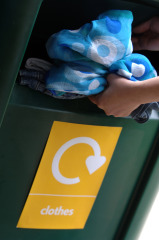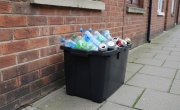More to be done to recover textiles, says WRAP

New research from the Waste and Resources Action Programme (WRAP) suggests that the UK should start focusing more on unlocking the potential economic value of the estimated one million tonnes of textiles sent to landfill from household waste each year.
The ‘UK Textile product flow and market development opportunities’ report reveals that consumers are throwing out unwanted textiles (mainly clothes, shoes and linens) despite the fact that they could be reused or recycled.
Marcus Gover, Director of Closed Loop Economy at WRAP, said: “In 2010, we threw out an estimated £238 million worth of textiles for waste collection and sent to landfill, yet all of this could have been reused, recycled or sent for energy recovery. If we were to recover just 10 per cent of that household textile waste, we could potentially unlock revenues of around £24 million. If we were to increase this figure to match what has already been achieved in recycling and reuse of other household waste materials, this amount could be even higher.
Acknowledging that recycling and reuse rates are increasing, Gover went on to say that more work needs to be done on recovering textiles outside of clothing. “Carpet recycling is growing fast from a very low starting point, and there are already a number of innovative methods and end markets for the recycled material, but further development of these is needed to ensure recycling is commercially viable.
“Mattress recovery is more difficult, but with the market price of steel steadily rising, it’s an area of growing interest and value – some mattresses contain as much as 50 per cent steel. In 2010, an estimated 84,500 tonnes of steel alone could have been recovered.”
Textile reports and guidance
WRAP has also launched three further textile related reports, as part of its ongoing efforts to address the issue of recycling both commercial and household textiles:
- The ‘Branded Workwear Report’ reveals that only 10 per cent of unwanted work clothing is currently recycled or reused and suggests the steps that could be taken to reduce waste and encourage reuse.
- The ‘Impact of Textile Feedstock Source on Value’ report assesses the impact that differing sources of recovered textiles have on the quality, and the subsequent value, of those textiles within the UK reuse and recycling markets.
- The ‘Textiles Washing and Drying Trial’ reports investigate the economic and environmental impacts of washing and drying contaminated textiles for reuse and recycling markets.
Aside from these, WRAP has also launched new guidance to help local authorities and textiles collectors increase reuse and recycling, and reduce the amount of textiles being sent to landfill. The guidance provides practical advice and examples of existing good practice for kerbside textile collection services, bring banks and community reuse initiatives.
“What our research demonstrates is that there are real opportunities here for organisations and individuals to reduce our carbon footprint by diverting textiles from landfill and extracting the maximum financial end economic benefits available from smarter reuse and recycling”, said Gover.
“WRAP’s role isn’t just about providing the sound research that spotlights the best areas for focus. It’s also about taking steps to help organisations tap into this potential. The new guidance we’re launching is just part of that work.”
The research has been welcomed by those in the textile industry, including Alan Wheeler, National Liaison Manager at the Textile Recycling Association, who said: “We are delighted with the work that is being undertaken through the Sustainable Clothing Roadmap and these publications represent a significant milestone. We look forward to working with WRAP, local authorities, charities and other stakeholders and to take forward many of the key recommendations made in order to divert an increasing amount of clothing and textiles away from the waste stream.”
WRAP is now planning to research the global rag and fibre market with the view of identifying ways to grow and develop new markets for these materials.





